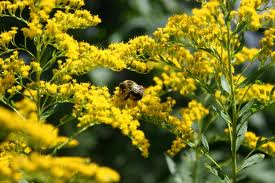Solidago Odora: Liberty Tea
After the Boston Tea Party of 1773 the colonists had only one good alternative: Goldenrod tea, and not just any Goldenrod, but the Solidago odora (sol-i-DAY-go oh-DOR-uh.) It became known as “Liberty tea” and was even exported to China.
As a kid growing up 120 miles from Boston I never thought of Goldenrod as a revolutionary potential tea. It was one of two blossoms that shaped my view of the world. In mid-May when the Lilacs bloomed I knew school was almost over for the summer. Who can ever forget the great joy that brought. And in late August the goldenrod began to bloom. Back to school. School always started the Tuesday after Labor Day. And to be fair that was usually exciting… for about a day.
Goldenrod is found throughout North American and you will read that nearly any goldenrod will make a tea, and that may be true if you have herbal applications in mind. But, leading the genus for a pleasant tasty tea is S. odora. It’s one of 25 goldenrods found locally and grows from Nova Scotia south to Florida west to Arkansas and Texas. It has also traveled some.
Goldenrod was introduced into Europe some 250 years ago. Solidago canadensisis now common in the wild there. In Germany it is considered an invasive species, which bring up a word associated with this plant: Ruderal.
Goldenrod is known as ruderal species, that is, it is among the first to take advantage of disturbed ground. It grows so quickly it can often makes a cleared site fragrant and attractive. It has also has gotten some bad public relations regarding allergies, most of it undeserved. Its pollen is heavy, doesn’t travel well, and is not the allergen it was thought to be. Usually the problem is ragweed. Goldenrod has, however, been linked to cases of dermatitis. The leaves are also toxic to sheep. And although goldenrod tea is a wholesome beverage, a toxic fungus that sometimes grows on the leaves may poison tea made from infected leaves. So make sure there are no problems with the leaves you collect.
As a kid I remember it as a particularly smelly because it was a common one to make into homemade and very inaccurate arrows for playing Cowboys and Indians. We Indians always won because unlike the cowboys with their fake guns we had Goldenrod arrows launched on alder bows. The alders were fairly smelly too. (I think that’s how the Cowboys knew where we were hiding.)
Of course bees use the Goldenrod as do butterflies and oddly woodpeckers. Bees make an excellent honey from the Goldenrod. The butterfly’s dependence is totally different. The butterfly lays an egg. The eggs becomes a larva that form a gall. Then certain parasitic wasps lay eggs in the larva in the gall. Woodpeckers, apparently experts in finding hidden food, peck open the galls and eat the growing insect inside.
Also know that the Goldenrod is not just another smelly flower with a pretty face. Thomas Edison experimented with goldenrod to make rubber, which it exudes naturally. In the 1930’s he managed to get 12% rubber out of each plant and Henry Ford gave Edison a Model T with tires made out of Goldenrod rubber. Edison turned his rubber research on the Goldenrod over to the government which carried it on until synthetic rubber was discovered during WWII. That ended Goldenrod as a source of rubber. However, its rubber is very strong and long-lasting, read better than synthetic rubber.
The Goldenrod is the state flower of Kentucky, Nebraska and South Carolina. It used to be the state flower of Alabama but was replaced with the camellia. Goldenrod also the state herb of Delaware. You didn’t know some states have State Herbs? You do now.
Solidago is from Latin and means to strengthen. This is in reference to the medicinal uses of the plant. Odora means fragrant.
Green Deane’s “Itemized” Plant Profile
IDENTIFICATION: Goldenrod is a perennial, 2-5 ft tall, hairy stems, alternating stemless single-veined narrow dark green leaves, smooth or hairy margins, pointed tips, 1-4 inches long becoming small towards the top, and smells like licorice when crushed (from small glands.) Dense golden-yellow flowers, late summer to mid-fall, in branched clusters at the tops of the stems. Goldenrods hybridized, so you night not be able to identify the exact species. You want to find a Goldenrod whose leaves smell like anise.
TIME OF YEAR: Leaves anytime, blossoms late summer to fall. Flowers yield a deep yellow dye.
ENVIRONMENT: Naturally prefers poor sandy soil but grows well in fertile soil. Will also grow in clay, full sun or semi-shade but will do better on a reasonably fertile site.
METHOD OF PREPARATION: Dried leaves and flowers to make tea. Make sure the leaves are fungus free. A toxic fungus can grow on the leaves. reports the seeds of several species were used as food. There are herbal applications.
HERB BLURB
Solidago odora leaves and tops (picked during the flowering period) have been used to make herbal medicines for a variety of disorders, including digestive and urinary problems, wounds, ulcers, and cancers. Hocking, 1997, reports S. canadensis was used as a carminative, diuretic and stimulant. Other uses included: Boiled in water for a syrup for treating colds; an oral poultice made from leaves was placed for a toothache; a poultice the roots to soothe burns and boils; a tea for bruises; a salve for insect stings and saddle sores on horses.


